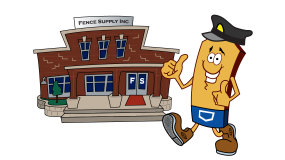Fabric — Weight and Height
Chain link fencing will add beauty, value, and security to your property and comes in many different heights and sizes. The most popular heights are the 4’, 5’ and 6’ heights, with a fabric weight of 11 gauge and 11 ½ gauge. Chain link fabric is also available in other heights and sizes such as 8’, 10’ and 12’, along with 12 ½ gauge and 9 gauge. Other special order sizes are available and Fence Supply Inc. can meet your specific needs for all your chain link projects.
Most residential applications will use the 11 ½ gauge fabric, while most commercial applications use either the 11 gauge or the 9 gauge fabric.
Posts — Size, Depth, and Gauge
To ensure a strong fencing solution, Fence Supply Inc. recommends setting posts for your chain link application at a depth of 18 to 24, and at a distance not greater than 10’ OC (on center). Most residential applications will set posts at the 18 depth, while commercial application may use either the 18 or 24 depth. Residential chain link posts are 2 3/8 diameter for the terminal (corner) posts and 1 5/8 diameter for the line posts. These posts are usually either a .055 gauge or .065 gauge.
Commercial applications usually use a 2 7/8 terminal post and 2 3/8 line post. These posts are usually heavier at .080 gauge or .095 (SS20) gauge. NOTE: The gauge of a post refers to the wall thickness. The higher the number, the thicker the post wall and the stronger and heavier the post will be.
Residential vs. Commercial Style Chain Link
Residential and commercial chain link have a lot of similarities, but there are a few important differences. Most residential chain link materials will be lighter weight than commercial applications. Commercial chain link installations may also include barbed wire and/or razor wire for added security, and is not normally seen on residential applications. Residential chain link in 4’ and 5’ heights will have fabric in a knuckle/knuckle configuration while 6’ and taller will have a knuckle/twist configuration.
Other differences in residential vs. commercial chain link include the fittings needed for each type of application. These fittings include the attachment hardware which consists of single tension bands (STB), single brace bands (SBB), one way caps, two way caps, RT caps, dome caps, rail ends (RE), loop tops, tension bars, top rail (TR),tie wire, tension wire, and pig rings.
While most residential applications use the basic set-up with one way and two way caps, commercial applications will use the SBB, RE, and dome caps to accomplish this part of the installation process. Most residential installations will use a lighter, smaller top-rail as well, usually a 1 3/8 top-rail while commercial applications will use a 1 5/8 or 1 7/8 top-rail.
Height of Fence
While personal preference may be the biggest reason for choosing a fence height, there may be other considerations as well. City codes or zoning laws may dictate the minimum and maximum height of a fence. Safety and security may be other considerations, as well as knowing that the proper height and placement of your chain link fence will add beauty and value to your home.
Barbed Wire / Razor Wire
Barbed wire and razor wire are excellent ways to add additional security to your chain link fence. These products are mainly used in commercial applications, but can be used on any chain link application where an added measure of security is required. These types of applications will require the terminal posts to be 17 higher than the top of the chain link fence, and barb arms to be affixed to the line posts to attach the barbed wire/razor wire.
Most barbed wire applications use a 3-strand set-up, but 2-strand is also used. When installing razor wire, the center strand of barbed wire is omitted and the razor wire is attached to the top and bottom strands of barbed wire using hog rings.
Bracing / Trussing
While bracing and trussing are more commonly used on commercial or heavy duty chain link applications, they can be used on any chain link installation where extra support is needed. A brace rod, usually made of 1 5/8 tubing, is used in conjunction with the appropriate rail end (2-hole RE), truss rod, and truss rod tightener. This system gives additional support in areas that may need it, such as corners or gate posts.
Chain Link Colors
Chain link is available in several colors of vinyl coated chain link. The most common colors are black and green. The standard colored chain link is 9 gauge after coating, and can add an additional level of beauty to your home. Colored chain link tends to blend in with the surroundings, making it less noticeable at a distance.
Tool Rental
There are many tools available to make your chain link installation easier. Fence Supply Inc. has these tools available for sale or for rent. Our Little Beaver augers make digging your post holes a breeze. Our Post Popper allows easy extraction of old posts. Use our Come-along in combination with our Finger and Stretching Bar to make stretching your fence an easy task. We also have pipe cutters available for any pipe cutting needs you may have. Please see our Tool Rental section for a complete list of tools available.
Gates
There are many excellent choices for gates for a chain link fence. The most common is either the single-or double-swing gate. This gate attaches with bolts on pin hinges and gate clamps and uses a bolt-on fork-latch assembly for latching and locking the gate. Double-swing gates can use a drop bar assembly to lock one panel to the ground while the other panel latches and locks to the first panel with the normal fork latch assembly. Commercial double drive swing gates can use an industrial drop bar (IDB) for additional security.
Another great choice for chain link gates is the safety roller gate. This gate uses a track assembly that attaches to the fence posts via pipe track brackets. Roller assemblies attach to the rear of the gate and it glides on the pipe track while the front of the gate is supported by a front wheel that rolls along the ground. A stable surface such as concrete, asphalt, or hard pack is needed for this type of gate for smooth operation.
Cantilever gates are also a good choice for chain link gates but are more commonly used in heavy duty or commercial applications. A cantilever gate is fully suspended on the fence via cantilever rollers which attach to the fence posts via a U-clamp. A cantilever gate must be 1.5 times longer than the actual gate opening to provide for the cantilever action. Cantilever gates virtually eliminate the need for a smooth surface since they roll on the fence itself. Both the cantilever and safety roller gates can use the cantilever latch assembly for latching and locking the gate.
V-track slide gates are also an excellent gate solution. This type of gate requires a hard, flat, straight surface such as concrete or asphalt for mounting the V-track. The gate then slides on the V-track via four or six rollers mounted in boxes attached to the bottom of the gate frame. The top of the gate uses guide rollers attached to the fence posts to stabilize the top of the gate.
Many types and sizes of electric gate operators can be used on any of the gates above and are available at Fence Supply Inc. for your every gate installation need.



